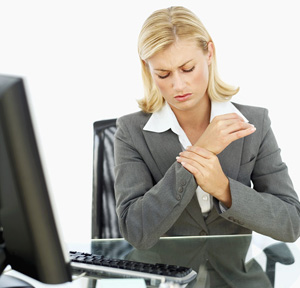Carpal tunnel syndrome (CTS) is one of the most common job-related injuries and is responsible for the highest number of days lost among all work related injuries. It is the reason for over two million visits to physicians’ offices and approximately 465,000 carpal tunnel release operations each year, making it the most frequent surgery of the hand and wrist.
Acupuncture is extremely effective at treating carpal tunnel syndrome; eliminating the need for surgery or the use of anti-inflammatory drugs or corticosteroids. In fact, one of the most common reasons that people get acupuncture is for repetitive stress injuries, including carpal tunnel syndrome. Recent studies even suggest that acupuncture may be more effective than corticosteroids when it comes to treating CTS.
What is Carpal Tunnel Syndrome?
The carpal tunnel is a narrow passageway in the wrist made up of ligaments and bones. The median nerve and the tendons that connect the fingers to the muscles of the forearm pass through this tightly spaced tunnel.
Carpal tunnel syndrome, also known as median nerve entrapment, occurs when swelling or irritation of the nerve or tendons in the carpal tunnel results in pressure on the median nerve. The median nerve controls sensations to the palm side of the thumb and fingers, as well as impulses to some small muscles in the hand that allow the fingers and thumb to move.
Symptoms usually start gradually, with frequent burning, tingling, or numbness in the palm of the hand and the fingers, especially the thumb, index and middle fingers. The symptoms often first appear during the night. As symptoms worsen, people might feel pain, weakness, or numbness in the hand and wrist, radiating up the arm during the day. Decreased grip strength may make it difficult to form a fist, grasp small objects, or perform other manual tasks. If not properly treated, CTS can cause irreversible nerve damage and permanent deterioration of muscle tissue.
Diagnosis and Treatment of Carpal Tunnel Syndrome with Acupuncture
From an Oriental medicine perspective, CTS is seen as a disruption of the flow of Qi and Blood within the area and associated with Cold, Dampness or Wind penetrating the muscles and sinews of the wrist. Acupuncture points, stretching exercises, herbal remedies and nutritional supplements are chosen to treat accordingly.
As well as reducing the swelling, inflammation and pain in the wrist, acupuncture addresses any headaches, neck pain, shoulder stiffness and sleeping problems that often accompany this condition.
Your treatment may also take into account any underlying conditions that contribute to the development of CTS including obesity, rheumatoid arthritis, thyroid problems, diabetes, hormonal changes of pregnancy and menopause.
If you or someone you love suffers carpal tunnel syndrome, please call to find out more about how acupuncture and Oriental medicine can help you.
Acupuncture is as effective as the corticosteroid, prednisone, for the treatment of carpal tunnel syndrome (CTS), according to a new study.
The randomized, controlled study that was published in the May 2009 issue of The Clinical Journal of Pain, investigated the efficacy of acupuncture compared with steroid treatment in patients with mild-to-moderate carpal tunnel syndrome as measured by both nerve conduction studies and symptom assessment surveys.
Seventy-seven patients were randomly divided into 2 groups. One group received eight acupuncture treatments over four weeks, and the other group received oral doses of prednisone, daily, for four weeks. The results showed that acupuncture was just as effective as the corticosteroid for pain, numbness, tingling and weakness. For the symptoms of night time awakening and motor function, the acupuncture group had better results.
The researchers concluded that acupuncture is a safe and effective treatment option for CTS for those who experience side effects to oral steroids or for those who do not opt for early surgery.
Sources:
Acupuncture: A Comprehensive Text. By Shanghai College of Traditional Chinese Medicine, 1981
Plastic and Reconstructive Surgery: Volume 105(5) April 2000 pp 1662-1665
The Clinical Journal of Pain. 25(4):327-333, May 2009.
doi: 10.1097/AJP.0b013e318190511c

